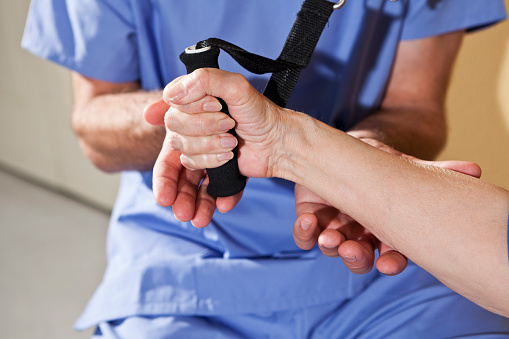目次
重度麻痺を呈する脳卒中片麻痺例における非麻痺側上肢への介入の有効性を示唆する論文
脳卒中片麻痺症例に対する運動療法の考え方も以前と比較するとかなり変化しましたね.
昔は非麻痺側機能を向上させることで早期にADL獲得をなんて方法論が主流であった時代もありましたが,半球間抑制といった概念が登場してからというもの,非麻痺側の過度な使用が麻痺側の機能回復の妨げになることも明らかにされております.
そんな中で非麻痺側上肢に対する介入というのは以前より軽視されている印象があります.
今回は重度麻痺を呈する脳卒中片麻痺例における非麻痺側上肢への介入の有効性を示唆する論文をご紹介させていただきます.

今回ご紹介する論文
Front Hum Neurosci. 2021; 15: 645714.
Published online 2021 Mar 12. doi: 10.3389/fnhum.2021.645714
Remedial Training of the Less-Impaired Arm in Chronic Stroke Survivors With Moderate to Severe Upper-Extremity Paresis Improves Functional Independence: A Pilot Study
Candice Maenza,1,2 David A. Wagstaff,3 Rini Varghese,4 Carolee Winstein,4 David C. Good,1 and Robert L. Sainburg1,2,*
今回ご紹介する論文は2021年に掲載された論文です.
研究の目的
The ipsilesional arm of stroke patients often has functionally limiting deficits in motor control and dexterity that depend on the side of the brain that is lesioned and that increase with the severity of paretic arm impairment. However, remediation of the ipsilesional arm has yet to be integrated into the usual standard of care for upper limb rehabilitation in stroke, largely due to a lack of translational research examining the effects of ipsilesional-arm intervention. We now ask whether ipsilesional-arm training, tailored to the hemisphere-specific nature of ipsilesional-arm motor deficits in participants with moderate to severe contralesional paresis, improves ipsilesional arm performance and generalizes to improve functional independence.
脳卒中例の非麻痺側には機能的に限界のある運動制御および巧緻性の障害があることが多く,これは病変のある側の脳に依存し,麻痺側の障害の重症度に応じて増加することが知られております.
しかしながら非麻痺側上肢への介入の効果を検証した研究というのはあまり多くなく,そのため非麻痺側上肢の機能改善が脳卒中症例のの上肢リハビリテーションの通常の標準治療にはまだ組み込まれていないことが多いでしょう.
この研究では,中等度から重度の運動麻痺を有する対象者の非麻痺側上肢の運動障害の半球特異的な性質に合わせた非麻痺側上肢トレーニングが,非麻痺側上肢のパフォーマンスを改善し,機能的自立度を改善に有効かどうかを明らかにすることを目的としております.
研究の方法
We assessed the effects of this intervention on ipsilesional arm unilateral performance [Jebsen-Taylor Hand Function Test (JHFT)], ipsilesional grip strength, contralesional arm impairment level [Fugl-Meyer Assessment (FM)], and functional independence [Functional independence measure (FIM)] (N = 13). Intervention occurred over a 3 week period for 1.5 h/session, three times each week. All sessions included virtual reality tasks that targeted the specific motor control deficits associated with either left or right hemisphere damage, followed by graded dexterity training in real-world tasks. We also exposed participants to 3 weeks of sham training to control for the non-specific effects of therapy visits and interactions. We conducted five test-sessions: two pre-tests and three post-tests.
この研究ではこの介入が非麻痺側上肢パフォーマンス[Jebsen-Taylor Hand Function Test (JHFT)],非麻痺側の握力,麻痺側上肢の運動障害レベル[Fugl-Meyer Assessment (FM)],および機能的自立[Functional independence measure (FIM)]に及ぼす効果を評価しております(N = 13).
介入は3週間にわたり,1回1.5時間,毎週3回行われております.
すべてのセッションで,左右どちらかの半球の損傷に伴う特定の運動制御障害を対象としたバーチャルリアリティのタスクを行い,その後,実環境でのタスクで段階的に巧緻性トレーニングを行っております.
また治療のための訪問や交流による非特異的な影響を除外するために,3週間のプラセボトレーニングも実施しております.
研究の結果
Our results indicate substantial improvements in the less-impaired arm performance, without detriment to the paretic arm that transferred to improved functional independence in all three posttests, indicating durability of training effects for at least 3 weeks. We provide evidence for establishing the basis of a rehabilitation approach that includes evaluation and remediation of the ipsilesional arm in moderately to severely impaired stroke survivors.
非麻痺側上肢機能が大幅に向上し,麻痺側上肢の機能改善に悪影響を及ぼすことなく,3回の介入後の評価で機能的自立度が向上し,この効果はトレーニング効果が少なくとも3週間は持続することが示されております.
研究の結論
This study was originally a crossover design; however, we were unable to complete the second arm of the study due to the COVID-19 pandemic. We report the results from the first arm of the planned design as a longitudinal study.
この研究は中等度から重度の脳卒中例において,非麻痺側上肢機能の評価と改善を含むリハビリテーションアプローチの基礎を確立するためのエビデンスを提供するものになります.
この研究は当初クロスオーバーデザインでありましたが,COVID-19パンデミックの影響で第2群を完了することができませんでした.
今回は重度麻痺を呈する脳卒中片麻痺例における非麻痺側上肢への介入の有効性を示唆する論文をご紹介させていただきました.
ポイントは麻痺側上肢機能の改善を妨げることの無い介入方法というところでしょうか.
確かに運動麻痺が重度な症例ほど非麻痺側上肢の拙劣さというは顕著な印象がありますので,ここへの介入というのは必須でしょうね.
この研究は慢性期の中等度~重度の運動麻痺を呈したクライアントを対象にしておりますので,非麻痺側上肢への介入が廃用に伴う由来する体幹機能の改善に結び付いた可能性もありますね.
改めて非麻痺側上肢機能にも目を向ける必要性を示唆する論文ですね.






